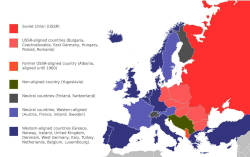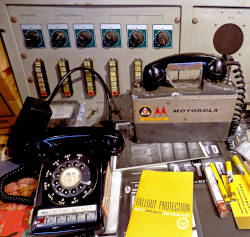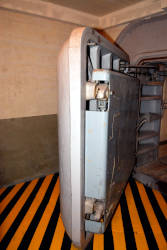Secret Bunkers
Nuclear Bunkers





After the Second World War, the alliances of the former allies broke apart, the political systems were too different. Capitalist countries on one side, communist on the other, the Cold War began. The governments of many countries, especially on the "front" in Europe, began to prepare for this confrontation with buildings. And this did not only include border fortifications and defensive installations. A hit with an atomic bomb could easily destroy bunkers from the Second World War. So it suddenly became important to build special bunkers against this danger. Besides the fact that they were deeper and had thicker walls, they were also equipped with systems to filter the radioactive fallout. And very important: they were top secret! Because you cannot hit bunkers with a nuclear bomb if you don’t know where they are. That’s why nuclear bunkers are usually called secret bunkers in English.
In many countries there were so-called government bunkers. Of course, the obvious thought is that the powerful build a safe place for themselves so that they don’t go down with the rest when they have fucked up the world. However, it is not that simple. The bunkers were uncomfortable to say the least, the supplies were only calculated to last about four weeks, and the essential aspect was communication. They actually served to maintain law and order during the hot phase of the war, in the hope that there would still be a place habitable on the surface afterwards. So this is not the type of bunker which allowed generations of inhabitants to avoid the radioactive surface. As far as we know such bunkers did not exist, only in movies and computer games. They were simply too difficult to build and far too expensive.
Most of the atomic bunkers were probably built in Great Britain, where each county government had to prove it had its own bunker. But you can find them in practically every country. The Germans even have the peculiarity of having bunkers from both sides of the Iron Curtain, there is the bunker of the Federal Government near Bonn in the northern Eifel and the bunker of the GDR government in the Thuringian Forest.
There were secret bunkers in both the military and civilian sectors, and even among the military bunkers, the bunkers for communications far outweighed the civilian ones. Only in the U.S.A. and the Soviet Union are there also missile bunkers, in which nuclear weapons, mostly in the form of intercontinental missiles, were stored. Individual facilities in the U.S.A. have now also been opened to the public, but as far there are few such facilities in the Soviet Union. It is not known how many still exist; one can only hope that the majority have been dismantled as a result of disarmament in recent decades.
Then, of course, there were a small number of bunkers for the civilian population, which came under the heading of civil defence. These were often existing underground structures, such as large subway stations, which had storage rooms and inconspicuous gates for locking the station. But there were also bunkers built specifically for this purpose, especially hospital bunkers. But if you realistically add up the bunkers, there would not have been room for more than one per thousand of the population, probably much, much less.
Finally, there are bunkers for all kinds of security tasks, cultural bunkers, warehouses with archives of plant seeds, library bunkers and bank bunkers. These certainly also have a task outside the Cold War, securing their contents from non-warlike threats: Earthquakes, volcanic eruptions, meteorites, ecological disasters and zombie apocalypses. These were not dissolved with the end of the Cold War, but for this reason they are not open to the public today.
Around 1993, however, after the end of the Cold War, the moment of truth had come for many of these rather expensive objects. The governments of most countries dissolved the bunkers that had now become superfluous, left them to decay or destroyed them. Some were also sold to private owners or handed over to associations. Some were opened as tourist attractions in the following years.
But the preservation of such structures involves budgets in the millions. Unheated buildings become damp, mouldy and at some point the fabric of the building is inevitably attacked. And so the bunkers, which are looked after by associations on a voluntary basis, will only be open to visitors for a limited time.
- Examples
 Bunkermuseum Wurzenpass
Bunkermuseum Wurzenpass Command Bunker Kemmel
Command Bunker Kemmel Diefenbunker
Diefenbunker Festungsmuseum Crestawald
Festungsmuseum Crestawald Festung Fürigen
Festung Fürigen Fort de Litroz
Fort de Litroz Null Stern Hotel
Null Stern Hotel Festungsmuseum Reuenthal
Festungsmuseum Reuenthal Festung Vitznau
Festung Vitznau Underground Project 131
Underground Project 131 The Shelter
The Shelter Beijing’s Underground City
Beijing’s Underground City Berliner Unterwelten
Berliner Unterwelten Atombunker der Bundesregierung
Atombunker der Bundesregierung Bunkermuseum Rennsteig
Bunkermuseum Rennsteig Bunker Eichenthal
Bunker Eichenthal Bunker Falkenhagen
Bunker Falkenhagen Bunker Harnekop
Bunker Harnekop Ausweichsitz Nordrhein-Westfalen
Ausweichsitz Nordrhein-Westfalen Bunker am Kap Arkona
Bunker am Kap Arkona Zivilschutzbunker Köln-Kalk
Zivilschutzbunker Köln-Kalk Kulturbunker Barbarastollen
Kulturbunker Barbarastollen The Story of Berlin
The Story of Berlin Bunker Wollenberg
Bunker Wollenberg Bunkerpark Wünsdorf
Bunkerpark Wünsdorf Essex Secret Bunker
Essex Secret Bunker Hack Green Secret Nuclear Bunker
Hack Green Secret Nuclear Bunker Kelvedon Hatch Secret Nuclear Bunker
Kelvedon Hatch Secret Nuclear Bunker Scotland’s Secret Bunker
Scotland’s Secret Bunker Sziklakórház Múzeum
Sziklakórház Múzeum 3rd Infiltration Tunnel
3rd Infiltration Tunnel Tito’s Bunker
Tito’s Bunker Bunker GO-42
Bunker GO-42 Tham Pha Thai
Tham Pha Thai Tham Ruesi Sombat
Tham Ruesi Sombat Greenbrier Bunker
Greenbrier Bunker Titan Missile Museum
Titan Missile Museum Củ Chi Tunnels
Củ Chi Tunnels

 Index
Index Topics
Topics Hierarchical
Hierarchical Countries
Countries Maps
Maps Search
Search